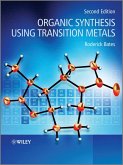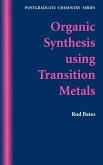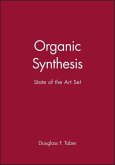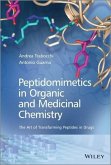Recent significant advances with transition-metal-mediated reactions have opened promising new routes to complex aromatic compounds and have been the subject of intense research in recent years. Featuring practical and efficient reactions to help organic chemists synthesize an important class of compounds, Transition-Metal-Mediated Aromatic Ring Construction provides a valuable guide to methods, synthetic routes, and strategies to construct aromatic rings. Chapters devoted to efficient and practical reactions demonstrate how to use them for the synthesis of various complex aromatic compounds.
State-of-the-science methods, synthetic routes, and strategies to construct aromatic rings The development of new reactions for the synthesis of aromatic compounds is a highly active research area in organic synthesis, providing new functional organic materials, functional reagents, and biologically active compounds. Recently, significant advances in transition-metal-mediated reactions have enabled the efficient and practical construction of new aromatic rings with useful properties and applications. This book draws together and reviews all the latest discoveries and methods in transition-metal-mediated reactions, offering readers promising new routes to design and construct complex aromatic compounds. Integrating metal catalysis with aromatic compound synthesis, Transition-Metal-Mediated Aromatic Ring Construction offers a practical guide to the methods, synthetic routes, and strategies for constructing aromatic compounds. The book's five parts examine: * [2+2+2], [2+2+1], and related cycloaddition reactions * [4+2], [3+2], and related cycloaddition reactions * Electrocyclization reactions * Coupling and addition reactions * Other important transformations, including methathesis reactions and skeletal rearrangement reactions Edited by Ken Tanaka, an internationally recognized expert in the field of transition-metal catalysis, the book features authors who are leading pioneers and researchers in synthetic reactions. Their contributions reflect a thorough review and analysis of the literature as well as their own firsthand laboratory experience developing new aromatic compounds. All chapters end with a summary and outlook, setting forth new avenues of research and forecasting new discoveries. There are also references at the end of each chapter, guiding readers to important original research reports and reviews. In summary, Transition-Metal-Mediated Aromatic Ring Construction offers synthetic chemists a promising new avenue for the development of important new aromatic compounds with a broad range of applications.
State-of-the-science methods, synthetic routes, and strategies to construct aromatic rings The development of new reactions for the synthesis of aromatic compounds is a highly active research area in organic synthesis, providing new functional organic materials, functional reagents, and biologically active compounds. Recently, significant advances in transition-metal-mediated reactions have enabled the efficient and practical construction of new aromatic rings with useful properties and applications. This book draws together and reviews all the latest discoveries and methods in transition-metal-mediated reactions, offering readers promising new routes to design and construct complex aromatic compounds. Integrating metal catalysis with aromatic compound synthesis, Transition-Metal-Mediated Aromatic Ring Construction offers a practical guide to the methods, synthetic routes, and strategies for constructing aromatic compounds. The book's five parts examine: * [2+2+2], [2+2+1], and related cycloaddition reactions * [4+2], [3+2], and related cycloaddition reactions * Electrocyclization reactions * Coupling and addition reactions * Other important transformations, including methathesis reactions and skeletal rearrangement reactions Edited by Ken Tanaka, an internationally recognized expert in the field of transition-metal catalysis, the book features authors who are leading pioneers and researchers in synthetic reactions. Their contributions reflect a thorough review and analysis of the literature as well as their own firsthand laboratory experience developing new aromatic compounds. All chapters end with a summary and outlook, setting forth new avenues of research and forecasting new discoveries. There are also references at the end of each chapter, guiding readers to important original research reports and reviews. In summary, Transition-Metal-Mediated Aromatic Ring Construction offers synthetic chemists a promising new avenue for the development of important new aromatic compounds with a broad range of applications.
"In summary, I personally have read Transition-Metal-Mediated Aromatic Ring Construction with great interest, and I believe this book is a rich source for both academic and industrial researchers. It provides a valuable addition to the range of textbooks on organic synthesis, aromatic rings, and heterocyclic chemistry. Therefore, I warmly recommend this book and I will strongly encourage my students and colleagues to explore it." (Angew. Chem. Int. Ed, 1 May 2014)








